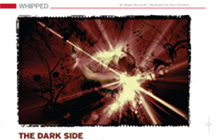THE DARK SIDE: WELCOME TO THE MAD PURSUIT OF NIGHT CLIMBING
(Part of an on-going series on my blog of posts from my column Whipped, for Climbing Magazine. February, 2007 Installment)
 Four hundred feet up Eldorado Springs Canyon’s Yellow Spur, pigeon shit on my lips and headlamps around my ankles,I screamed at my belayer to stop pulling me off. It was well past 10 p.m., and what we were doing would easily qualify as an epic — except we’d chosen it.
Four hundred feet up Eldorado Springs Canyon’s Yellow Spur, pigeon shit on my lips and headlamps around my ankles,I screamed at my belayer to stop pulling me off. It was well past 10 p.m., and what we were doing would easily qualify as an epic — except we’d chosen it.
Some things are good ideas. Others are, well, potentially good ideas. Take night climbing. It had never occurred to me to intentionally go climbing in the dark. Sure, I’d done full-moon ascents of a few easy climbs, but I’d never sat down with my tick list and thought, oh yes, that one would be choice in the blackness. But then, Gary Ryan came along.
Gary, as it turns out, is a boaster. Most climbers would brag about a new double set of cams or sick new ice tools. Gary is British, which makes everything he says sound somewhat jovial and potentially untrue.
“I have four Ions,” he told me one hot afternoon in Eldo, as we both chased shade on the Bastille.
“I think you have four billion,” I said.
“The head torches,” he replied.
“Are we still talking about climbing?”
We were, in fact, just beginning to. Because he couldn’t get any climbing in otherwise, Gary had recently become obsessed with headlamp-assisted night climbing. Working more than 10 hours a day for a climbing-shoe company had cramped his climbing style, so he’d opted to forego another frivolous activity — sleep — in order to get some rock time.
Gary had a strategy for his multiple headlamps: “You strap ‘em to your legs,” he explained. “Your wrists, too. Accuracy, right? Climbing.” After eight years in Colorado, I was primed for any new way to keep the home turf interesting.
Besides, Tommy Caldwell freed two El Cap routes in 24 hours with just one headlamp, and Daniel Woods redpointed 5.14 sport and climbed V12 by a head torch — how hard could it be?
A few weeks later at dusk, Gary and I met in Eldo. As we reached the base of the five-pitch Yellow Spur(III 5.10b), we turned on the torches. Gary had told me to bring along all of mine; I had two. He had six, including the aforementioned Black Diamond Ions, and promised to share. I strung one headlamp around my neck, so I could see the rack; wrapped the Ions twice around my ankles, cinching them tight and positioning the microbeams to shine along my big toes; decided against the ones on my wrists; and began to covet the high beam on Gary’s head.
The full moon was rising behind the ridge, though it wouldn’t light the route until the penultimate pitch. At the base of the first rope length — a tricky 5.9 traverse by day — we had only the ambient glow of starlight as our guide. All around us, Eldo’s long, lean arêtes towered into oblivion. I cast the weak beam of my on-the-head torch upward, searching for the first piece, a fixed piton.
“How’s it going over there?” Gary asked, watching my light hit the pin, then the ground, then the pin again. “You sure you want to get right on it?”
I laced up my shoes, saying, “No problem.”
“I can lead the first pitch, give you a chance to get the hang of it.”
Because it was dark, I’m relatively certain he could not see my eyes narrow. “Nah — the lights on my feet might help me find the footholds,” I said, looking for the traverse’s obscure foot edges. As I climbed up and then down the first 15 feet, I realized I was wrong. The main head torch didn’t offer enough illumination, and the headlamp swinging from my neck created dizzying circles of light. Downclimbing was even harder: I took three minutes to reverse the boulder move to the ground, which, in my darkened, paranoid state, seemed much more distant than it really was. “The frickin’ holds get smaller at night!” I said, passing off the rack.
I got the hang of it quickly … when following. I would spot each hold, set up my feet, and then reach through until my hand intersected the spotlight and the rock. Jams were the easiest — you could feelthem — while edges took a thorough double-checking. I climbed quickly, highstepping and matching through moves that felt like eerie shadows of their daylight selves. Back on the lead, I rotated my head in the hopes that casting my beam in wider circles would paint the cliff with light. Light, unfortunately, does not work that way. Eventually, I grokked that I could only see what was directly in front of me, and climbing became rhythmic and simplified. A rather tightly wound individual, perhaps I’d finally found my moving meditation.
Then, just as I was about to achieve nirvana, seven pigeons flew out of the crack, flapping against my helmet as I led the 5.8+ fourth pitch. I went from a zen-like state to hysteria in less than two seconds, accompanied by involuntary shrieking — I didn’t realize I was doing it until a drop of poo landed on my upper lip. Gary, thinking I was falling, pulled the rope tight. This time I yelled with intention, “Noooo!” and then, more precisely, “Pigeons!”
Now might be a good time to explain that while Gary and another partner were night climbing on the same route one week earlier, his partner took a 50-footer, broke her ankle, and bled a lot. Enacting a heroic rescue, Gary got her down from the climb, piggybacked her a steep mile to the car, and then drove her to the ER — all in two hours. Apparently, her screaming and my screaming sounded identical. ‘Bloody hell, not again,’ was all Gary could think, reeling in slack.
My left foot was in the crack, and my right stemmed out on a face hold. As Gary started taking, I pumped my fists against the pigeon shit, scrabbling for a slippery jam. Then, just as I reversed barn-doored onto my left leg, the rope went loose. I spent the next two minutes steadying my breathing and tugging on the cord until it felt deliciously limp.
“Don’t like those pigeons, do you?” Gary said upon joining me at the anchor.
“I have bird issues.”
Gary shone his headlamp directly at me. “What kind of bird issues?” he asked.
“Arctic terns.” At age 17, on an island in the Northwest Territories, I and five others had been assaulted by several dozen of the winged devils, forcing us to belly-crawl back to our canoes as they herded us along, nipping at our necks. The words alone made me shiver, ashad my brush with the infamous Eldo death pigeons. I handed the rack to Gary, and we continued upward.
We topped out after midnight, the five pitches we’d climbed swallowed by blackness. We rappelled without a hitch and were back at the car before 2 a.m. Gary had to go home — he had work at seven. I’d be lying if I said I was disappointed we couldn’t do more. I felt tough packing away my headlamps … until I remembered Caldwell had freed 5.12 trad on El Cap by headlamp, though I consoled myself by rationalizing that not all his pitches were that hard. I drove home envisioning a semi-equivalent Eldo link-up: the Bastille, Wind Tower, Redgarden Wall, Rincon — stacks of 5.7 to 5.11 up every formation. Night climbing suddenly held all the potential in the world.
In fact, I see a whole new sub-sport — a canny solution for busy climbers — in the offing. Anew grading system could follow, too, with climbers garnishing their route logs with hip qualifiers: e.g., III 5.10b N+ (N for nighttime, + for total blackness, – for moonlight, etc.). And think of the accessories: shoes with lights, reflective climbing clothing, cams that glow in the dark. And a pigeon sensor — that would definitely come in handy, too.

